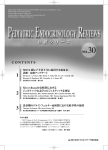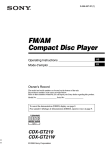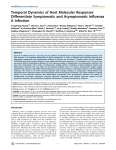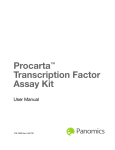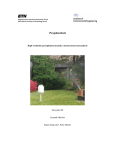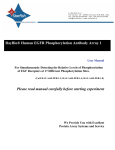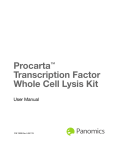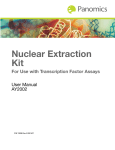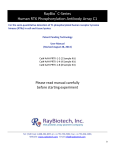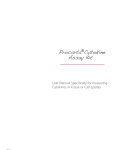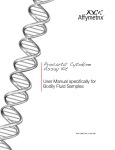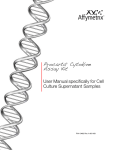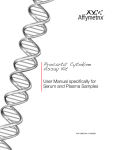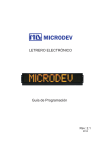Download Procarta™ SH2 Domain Plex
Transcript
Procarta SH2 Domain Plex ™ User Manual P/N 14575 Rev. B 072507 DRAFT July 25, 2007 11:17 am SH2Ttile.fm Panomics, Inc. Procarta SH2 Domain Plex User Manual Copyright © Copyright 2007, Panomics, Inc. All rights reserved. Trademarks Procarta is a trademark of Panomics, Inc. xMAP and Luminex are registered trademarks of Luminex Corporation. Bio-Plex is a registered trademark of Bio-Rad Laboratories, Inc Citing Procarta in Publications When describing a procedure for publication using this product, we would appreciate it if you would refer to it as the Procarta™ SH2 Domain Plex Assay Kit. If a paper cites a Procarta product and is published in a research journal, the lead author(s) may receive a travel stipend for use at a technology conference or tradeshow by sending a copy of the paper to our technical support group at [email protected] or via fax at (510) 818-2610. Disclaimer Panomics, Inc. reserves the right to change its products and services at any time to incorporate technological developments. This manual is subject to change without notice. Although this manual has been prepared with every precaution to ensure accuracy, Panomics, Inc. assumes no liability for any errors or omissions, nor for any damages resulting from the application or use of this information. DRAFT July 25, 2007 11:17 am SH2Ttile.fm Contents About the User Manual . . . . . . . . . . . . . . . . . . . . . . . . . . . . . . . . . . . . . . . . . . . . . . . . . 5 Who Should Read this Manual. . . . . . . . . . . . . . . . . . . . . . . . . . . . . . . . . . . . . . . 5 What this Manual Covers . . . . . . . . . . . . . . . . . . . . . . . . . . . . . . . . . . . . . . . . . . . 5 Safety Warnings and Precautions . . . . . . . . . . . . . . . . . . . . . . . . . . . . . . . . . . . . 5 For More Information . . . . . . . . . . . . . . . . . . . . . . . . . . . . . . . . . . . . . . . . . . . . . . 5 About the Procarta SH2 Domain Plex Assay Kit . . . . . . . . . . . . . . . . . . . . . . . . . . . . . . 6 Procarta SH2 Assay Defined . . . . . . . . . . . . . . . . . . . . . . . . . . . . . . . . . . . . . . . . 6 Overview of Assay Workflow . . . . . . . . . . . . . . . . . . . . . . . . . . . . . . . . . . . . . . . . . . . . . 7 Kit Contents and Storage . . . . . . . . . . . . . . . . . . . . . . . . . . . . . . . . . . . . . . . . . . . 9 Kit Handling and Formats. . . . . . . . . . . . . . . . . . . . . . . . . . . . . . . . . . . . . . . . . . . 9 Required Materials and Equipment Not Provided . . . . . . . . . . . . . . . . . . . . . . . . . . . . . 9 Equipment . . . . . . . . . . . . . . . . . . . . . . . . . . . . . . . . . . . . . . . . . . . . . . . . . . . . . . 9 Set-Up and Operation of the Vacuum Manifold System . . . . . . . . . . . . . . . . . . . . . . . 10 About Using the Vacuum Manifold . . . . . . . . . . . . . . . . . . . . . . . . . . . . . . . . . . . 10 Sealing Filter Plates . . . . . . . . . . . . . . . . . . . . . . . . . . . . . . . . . . . . . . . . . . . . . . 10 Setting Up and Calibrating the Manifold. . . . . . . . . . . . . . . . . . . . . . . . . . . . . . . 10 Operating the Manifold . . . . . . . . . . . . . . . . . . . . . . . . . . . . . . . . . . . . . . . . . . . . .11 Assay Preparation . . . . . . . . . . . . . . . . . . . . . . . . . . . . . . . . . . . . . . . . . . . . . . . . . . . . 12 About Preparing Samples . . . . . . . . . . . . . . . . . . . . . . . . . . . . . . . . . . . . . . . . . 12 Recommended Assay Controls . . . . . . . . . . . . . . . . . . . . . . . . . . . . . . . . . . . . . 12 Assay Procedure . . . . . . . . . . . . . . . . . . . . . . . . . . . . . . . . . . . . . . . . . . . . . . . . . . . . . 13 Assay Guidelines . . . . . . . . . . . . . . . . . . . . . . . . . . . . . . . . . . . . . . . . . . . . . . . . 13 Before You Start . . . . . . . . . . . . . . . . . . . . . . . . . . . . . . . . . . . . . . . . . . . . . . . . . 13 Preparing Cell Lysates . . . . . . . . . . . . . . . . . . . . . . . . . . . . . . . . . . . . . . . . . . . . 13 Performing the SH2 Domain Plex Assay . . . . . . . . . . . . . . . . . . . . . . . . . . . . . . 14 Troubleshooting . . . . . . . . . . . . . . . . . . . . . . . . . . . . . . . . . . . . . . . . . . . . . . . . . . . . . . 17 Possible Problems and Recommended Solutions . . . . . . . . . . . . . . . . . . . . . . . 17 Contacting Panomics . . . . . . . . . . . . . . . . . . . . . . . . . . . . . . . . . . . . . . . . . . . . . . . . . . 18 Technical Help . . . . . . . . . . . . . . . . . . . . . . . . . . . . . . . . . . . . . . . . . . . . . . . . . . 18 For Additional Services . . . . . . . . . . . . . . . . . . . . . . . . . . . . . . . . . . . . . . . . . . . 18 Appendix I . . . . . . . . . . . . . . . . . . . . . . . . . . . . . . . . . . . . . . . . . . . . . . . . . . . . . . . . . . 19 Bead-Analyte Associations . . . . . . . . . . . . . . . . . . . . . . . . . . . . . . . . . . . . . . . . 19 Appendix II: Example Data . . . . . . . . . . . . . . . . . . . . . . . . . . . . . . . . . . . . . . . . . . . . . 20 Appendix III . . . . . . . . . . . . . . . . . . . . . . . . . . . . . . . . . . . . . . . . . . . . . . . . . . . . . . . . . 21 Sample and Blank Plate Layouts . . . . . . . . . . . . . . . . . . . . . . . . . . . . . . . . . . . . 21 Procarta Cytokine Assay User Manual iii About the User Manual About the User Manual Who Should Read Anyone that has purchased a Procarta SH2 Domain Plex Kit from Panomics to this Manual perform profiling of up to 30 different SH2 Domains using cell lysates. ] What this Manual This manual provides recommendations and step-by-step procedures for the Covers following: ♦ Set up and operation of the vacuum manifold system ♦ Sample and assay preparation ♦ Assay procedure ♦ Troubleshooting Safety Warnings CAUTION All chemicals should be considered potentially hazardous. We recommend that and Precautions this product and its components be handled by those trained in laboratory techniques and be used according to the principles of good laboratory practice. CAUTION This kit contains small quantities of sodium azide. Sodium azide reacts with lead and copper plumbing to form explosive metal azides. When disposing, flush drains with a large volume of water to prevent azide accumulation. Observe all state and local regulations for disposal. For More This product is intended for research use only. Not for diagnosis of disease in Information humans or animals. For information about the Procarta products mentioned in this manual, visit our website at www.panomics.com. Procarta SH2 Domain Plex User Manual Page 5 About the Procarta SH2 Domain Plex Assay Kit About the Procarta SH2 Domain Plex Assay Kit Procarta SH2 ♦ Assay Defined ♦ Luminex based assay for multiplexed SH2 Domain Measurement Rapidly profile up to 30 SH2 domains in each well of a 96 well plate ♦ Convenient easy-to-use kit including all necessary reagents for assay ♦ Mix and match from the 30 SH2 Domains to create custom plex sets ♦ Safe, fluorescent detection, with no radioactivity involved SH2 domains are one of the many protein domain families that mediate protein-protein interactions in signal transduction. Like other domains, SH2 domains are defined by a conserved region of amino acid residues. The folding characteristics of this sequence of 100-amino acids allow these domains to specifically recognize and bind to phosphotyrosine-containing ligands. There are approximately 120 different SH2 domains that bind to 110 different proteins in the human genome. These protein-protein interactions involving phosphotyrosines, like those made possible by SH2 domains, are a primary means of recruiting signaling proteins, and thus play a major role in signal transduction. SH2 domains can be found in enzymes, adaptor proteins, regulatory subunits of signaling proteins, scaffold proteins, transcription factors and oncogenic proteins. These proteins are integral to the signaling process because they act as adaptors between receptors and downstream signaling molecules, transmitting signals within cells and regulating the kinase activity of specific proteins. Protein phosphorylation is a major conduit of information for cellular responses, and defects in SH2 domain-dependent signaling are often directly or indirectly shown to be involved in human diseases. 1. Ligand binds to Receptor Tyrosine Kinase (RTK) 2. RTK is phosphorylated. 3. RTK recruits SH2 Protein Receptor Tyrosine Kinase P P P P SH2-ABL2 P P SH2- Proteins SH2-LCK SH2-ABL2 SH2-LCK SH2-Grb2 SH2-Grb2 SH2-CRK Procarta SH2 Domain Plex assays developed by Panomics are multiplex bead based assays designed to detect phosphotyrosine binding activity in various cell lysates. The assay is performed in 96-well microtiter filter plate format and is optimized for Luminex® and Bio-Plex® suspension array system, which uses xMAP® detection technology. Using this assay, phosphorylated receptor tyrosine kinases (RTK’s) can be detected simultaneously within 4 hrs with as little as 1 µg of the total cell lysate. Another key advantage of the Procarta SH2 Domain Plex assay is that customers can choose their analytes from the list of the SH2 domains available. At Panomics, we will pool the SH2-specific beads and provide in a ready to use format. Customers can design their own assay from the 30 SH2 Domains and create a plex from 3-29. Page 6 Procarta SH2 Domain Plex User Manual Overview of Assay Workflow Overview of Assay Workflow Step 1: Prepare cell cultures using appropriate cell treatments, ie EGF. Step 2: Prepare Cell Lysates from treated and untreated Cultured Cells using Lysis Buffer Step 3: Determine Protein Concentration of Samples (Lowry Assay, Bio-Rad DC Protein Assay) Step 4: Design plate layout to include appropriate controls and samples. Add cell lysates (contains phosphorylated receptor Tyrosine Receptor Kinase) to Capture Beads (SH2 Domains bound to Luminex Beads) in designated wells of the 96 well filter plate and incubate for 2 hours Step 5: Wash bead complex and add biotinylated anti-phosphotyrosine detection antibody. Incubate for 1 hour and wash bead complex Step 6: Add Streptavidin PE for fluorescent detection. Incubate for 30 minutes and wash complex. Read on Luminex instrument. Procarta SH2 Domain Plex User Manual Page 7 Overview of Assay Workflow bead 1 GST-ABL2 P P P P P P bead 4 bead 2 bead 3 GST-CRK GST-LCK P P P P P GST-GRB10 Panomics provides Luminex beads conjugated to GST-SH2 Fusion proteins Treated and untreated cell lysates are prepared containing phosphorylated and unphosphorylated Receptor Tyroskine Kinases (RTK) P phosphorylated receptor tyrosine kinases bead 1 bead 1 GST-ABL2 GST-ABL2 P P P P P P P P P P SH2 Conjugated beads are added to the cell lysates and only the specific SH2 bead will bind to the phosphorylated RTKs P P bead 3 bead 2 bead 4 GST-CRK GST-GRP10 GST-LCK Laser Excitation Fluorescence PE S bead 1 Streptavidin-PE B biotin-conjugated anti-tyrosine kinase antibody GST-ABL2 P P P P Anti-phosphotyrsine antibody is added, followed by the addition of the Streptavidin PE. The complex is then analyzed on the Luminex Instrument. The beads that do not have any bound RTKs will have little or no fluorescence. 10 Untreated 8 Treated 6 bead 3 P bead 2 bead 4 P 4 GST-CRK GST-GRP10 GST-LCK 2 0 Page 8 Bead 1 Bead 2 Bead 3 Bead 4 Procarta SH2 Domain Plex User Manual Required Materials and Equipment Not Provided Kit Contents and The Procarta SH2 Domain Plex Assay Kit contains the following components. Refer Storage to the product insert for quantities and details of components supplied. Procarta SH2 Domain Plex Assay Kit Component Kit Handling and ♦ Formats ♦ Storage Cell Lysis Buffer -20 °C Detection Antibody (Anti-phosphotyrosine) -20 °C Positive Control Cell Lysate -80 °C Negative Control Cell Lysate -80 °C Assay Buffer 2–8 °C Reading Buffer 2-8 °C Wash Buffer 2–8 °C Detection Antibody Dilution Buffer 2–8 °C Streptavidin-PE (SAPE) 2–8 °C SH2 Capture Beads 2–8 °C Filter Plate 15–30 °C Filter Plate Holder 15–30 °C Plate Seals 15–30 °C Store Reagents at appropriate temperatures listed above Reagents are guaranteed for 6 months upon receipt when stored properly. The Procarta SH2 Domain Assay Kit are available as: ♦ Standard pre-mixed 30 Plex Panel ♦ User selected panels, provided in premixed and ready to use format Required Materials and Equipment Not Provided Equipment Item Source Vacuum filtration system Millipore (P/N MAVM0960R and WP6111560) Microplate shaker Labline model 4625 or equivalent with 3 mm orbit Luminex or Luminex-based instrument MiraiBio, Bio-Rad or other Luminex instrument provider DC Protein Assay Bio-Rad Refrigerated Table Top Centrifuge Beckman Refrigerated Microcentrifuge Eppendorf Platform Rocker Labline model 5322-74 or equivalent Procarta SH2 Domain Plex User Manual Page 9 Set-Up and Operation of the Vacuum Manifold System Set-Up and Operation of the Vacuum Manifold System About Using the This topic describes how to set up and use the Millipore vacuum manifold. This Vacuum Manifold includes how to calibrate the pressure and important guidelines that will help to ensure good assay reproducibility. We recommend that you set up and calibrate the manifold before you start the assay to ensure the assay is performed without interruption. Sealing Filter ♦ Plates Lay a Plate Seal over the Filter Plate and roll a 5 mL serological pipet (or equivalent) over the Plate Seal to seal the Filter Plate. This ensures adequate plate sealing while avoiding any leakage due to capillary action. IMPORTANT To avoid Filter Plate leakages, do not seal Filter Plates using a rubber roller (or equivalent) as they apply significant pressure resulting in leakage. ♦ Seal all unused wells with an enclosed Plate Seal to ensure proper vacuum pressure. Setting Up and To set up and calibrate the manifold: Calibrating the Step Action Manifold 1 Set up the Filter Plate vacuum manifold as shown below. Follow the manufacturer’s manual for details. 2 Calibrate the vacuum pressure using the Filter Plate Holder: a. Place the Filter Plate Holder on top of the manifold. b. Turn on the vacuum. c. Press the corners of the Filter Plate Holder to form a tight seal. d. Set the pressure to 2–3 mm of Hg. IMPORTANT If the vacuum is too high, beads will be trapped on the filter. Page 10 Procarta SH2 Domain Plex User Manual Set-Up and Operation of the Vacuum Manifold System Operating the To operate the manifold: Manifold Step 1 Action Once the vacuum is set correctly, remove the Filter Plate Holder. Check vacuum calibration periodically. As a general guideline, 200 µL of solution should take approximately 3–5 seconds to clear the well of a Filter Plate. 2 For all filtration steps, turn the Filter Plate vacuum manifold on, transfer the Filter Plate to the vacuum manifold and then filter the solution. Avoid splashing and cross-contamination of wells during all wash steps. IMPORTANT During filtration, maintain the vacuum between 2–3 mm of Hg. Higher vacuum settings may result in Capture Bead loss. IMPORTANT Do not allow the Filter Plates to air-dry following washes. Immediately add the next component following each filtration step. 3 Break the vacuum immediately after each solution has been completely filtered from all wells (approximately 3–5 seconds). Note Wells typically filter at different rates. 4 Place the Filter Plate back on the Filter Plate Holder. 5 Following the last wash in each series, blot the bottom of the Filter Plate thoroughly with a paper towel to remove traces of Wash Buffer. Avoid touching the bottom of the Filter Plate with your fingers or to the bench during manipulations. Procarta SH2 Domain Plex User Manual Page 11 Assay Preparation Assay Preparation About Preparing Procarta SH2 Domain Plex assays are designed to measure multiple SH2 binding Samples domains from cell culture cell lysates. The concentration of sample lysate preparations must be greater than 1.0 µg/µl and stored at -80 degrees. For optimal performance, we recommend culturing the cells to 90% confluency using the appropriate growth media plus 10% fetal bovine serum (FBS). We then recommend culturing the cells in the appropriate media and 0.1% FBS for 16 hours followed by the appropriate treatment. Also, for optimizing the cell lysate concentrations, we recommend preparing a 4 fold linear dilution of a treated and untreated sample. Total cell lysate protein concentration should be 5, 2.5, 1.25 and 0.625 µg per well and the samples should be diluted in Cell Lysis Buffer with a final volume of 50 µl per well. Recommended Assay Background Control Assay Controls Assay background is the assay signal (median fluorescence intensity, MFI) generated by the assay components in the absence of sample. We recommend the following: Run an assay background control in every experiment to ensure optimal assay evaluation. Use Cell Lysis Buffer as the assay background control. Subtract the assay background MFI from the sample generated MFI. Cell Lysate Controls The Positive and Negative Control Cell Lysates are provided to enable the user to monitor assay performance under controlled sample conditions. These controls are included in the kit and are also available separately. We recommend the following: Run one or both Controls in every experiment to monitor day-to-day assay performance under controlled sample conditions. Negative Control As a negative control, the GST peptide has been conjugated to a bead and is added to the beads in the assay. There should be very minimal protein binding to the GST conjugated bead and therefore this control should have minimal MFI. Replicate Recommendations Technical replicates are replicate assays from a single sample. For example, a cell extract from a plate of cells can be divided into several portions and each portion run as a distinct samples in the Procarta SH2-Plex assay. Biological replicates are replicate assays from biologically-equivalent samples. For example, cell extracts obtained from different plates of cells that were subjected to the same treatment with each sample run as distinct sample in the Procarta SH2-Plex assay. For assays with 3-6 biological replicates, run one well/biological sample. For assays without biological replicates, run technical replicates; three wells/biological sample. Page 12 Procarta SH2 Domain Plex User Manual Assay Procedure Assay Procedure Assay Guidelines IMPORTANT For optimal assay performance and consistent results, please read these guidelines before proceeding with the assay. ♦ Avoid freeze/thawing of cell lysates. ♦ Follow the guidelines in “Set-Up and Operation of the Vacuum Manifold System” on page 10. ♦ During the incubation steps, place the Filter Plate on the Filter Plate Holder to prevent any accidental contact between the bottom of the Filter Plate and any absorbent surface. Cover the Filter Plate/Filter Plate Holder assembly with aluminum foil to prevent photobleaching of the fluorescent beads. ♦ Avoid applying the plate seals too tightly as this may cause well to well contamination upon removal. Before You Start Make sure the Luminex or Luminex-based instrument is turned on at least 30 minutes before you intend to read your plates. Preparing Cell Lysates Step 1 Action For Adherent Cells: After appropriate cell treatment, remove the cell culture media and wash with an equivalent volume of ice-cold PBS. Aspirate as much PBS from the plate as possible. For Suspension cells: After appropriate cell treatment, transfer cells to appropriate tube and centrifuge (bench top) at 500g (~2000 RPM) for 5 minutes at 4 °C. Remove the cell culture media and wash the cell pellet with ice-cold PBS. Centrifuge at 500g (~2000 RPM) for 5 minutes at 4 °C, to pellet the cells. Aspirate as much of the PBS from the tube as possible. 2 Remove Cell Lysis buffer from freezer and thaw on ice. For adherent cells: ♦ Add 500 µL of ice-cold Cell Lysis Buffer to the cells for 10 cm plate (5x10^6 1x10^7 cells), and 100 µL for one well of 6 well plate (10^6 cells). Ensure that the plate is evenly covered with the Cell Lysis Buffer by gently swirling. ♦ Put the plate on ice (ice bucket) then gently rock on a platform rocker for 5 minutes. ♦ For 10 cm plates, scrape cells off tissue culture dish with a plastic cell scraper and transfer the cell suspension to 1.5 mL microcentrifuge tubes. ♦ For 6-well plates, pipet Cell Lysis Buffer up and down to dislodge the cells. For suspension cells: ♦ Resuspend the cell pellet in 250 µL of Cell Lysis Buffer. ♦ Transfer resuspended cells to a 1.5 ml microcentrifuge and place on ice. ♦ Put the tube horizontally in a ice bucket then gently rock on a platform rocker for 5 minutes. 3 Using an ice and water mixture to keep the tubes cold, lyse the cells in each tube by sonicating for 2-3 seconds and placing the tube on ice for 15 seconds. Repeat this sonication and cooling process for 2 more times. Procarta SH2 Domain Plex User Manual Page 13 Assay Procedure Step Action 4 Centrifuge tubes at 9500g (~10,000 RPM) for 5 minutes at 4 °C. After centrifugation, a pellet should be visible and transfer supernatant (your cell lysate) to a clean, 1.5 ml microcentrifuge tube. 5 Determine protein concentration of cell lysates using the Bio-Rad DC Protein assay. The lysates can be used immediately or stored at -80°C in small aliquots for further use. Performing the To perform the assay: SH2 Domain Plex Step Action Assay 1 Mark the sample wells you want to use. A blank plate layout is provided in the appendix for your plate layout. 2 Seal the un-used wells of the plate with a Plate Seal provided in the kit before starting the assay. 3 Pre-wet the Filter Plate: a. Place the Filter Plate on the Filter Plate Holder. b. Add 100 µL of Assay Buffer to each non-sealed well. c. Incubate 5 minutes at room temperature. d. Remove the Assay Buffer with vacuum filtration. Assay Buffer should clear wells within 3–5 seconds. If outside this range, see “Set-Up and Operation of the Vacuum Manifold System” on page 10. e. Place the Filter Plate back on the Filter Plate Holder. IMPORTANT Do not invert the plate. 4 Add the Capture Beads: a. Vortex the Premixed Capture Bead solution for 30 seconds at room temperature. b. Pipet 50 µL of premixed beads to each assay well of the Filter Plate. c. Remove the buffer using the vacuum manifold. IMPORTANT Do not invert the plate. 5 Wash the Capture Beads: a. Pipet 150 µL of Wash Buffer to each assay well of the Filter Plate. b. Remove the Wash Buffer using the vacuum manifold. c. Blot the bottom of the Filter Plate with paper towels d. Place Filter Plate on the Filter Plate Holder. Page 14 6 Add 50 µL of Assay Buffer to each assay well of the Filter Plate. 7 For setting up the Positive and Negative Control Cell Lysates, add 195 µL of Cell Lysis Buffer to each control tube and invert to mix. 8 Add 50 µL of positive control, negative control, assay background control, and cell lysate samples to each well according to the plate layout sheet and seal the plate gently with a Plate Seal. Discard unused Control Cell Lysates. Procarta SH2 Domain Plex User Manual Assay Procedure To perform the assay: (continued) Step 9 Action Incubate and wash the Filter Plate: a. Completely wrap the Filter Plate and Filter Plate Holder with aluminum foil. b. Shake for 2 hours at 500 rpm at room temperature. Optionally, you can incubate overnight without shaking at 4°C, after the 2 hour shaking incubation step. c. Carefully remove the Plate Seal to avoid splashing the plate contents. d. Remove solution with vacuum filtration. IMPORTANT Do not invert the plate. e. Wash the plate three times with 150 µl/well of Wash Buffer. After the 3rd wash, blot the bottom of the Filter Plate with paper towels. f. Place the Filter Plate on the Filter Plate Holder. 10 Each Detection Antibody Tube is enough for 48 wells/samples. To prepare the detection antibody, add 500 µL of Detection Antibody Dilution Buffer to the Detection Antibody Tube. Gently mix and transfer to tube containing 2 mls of Detection Antibody Dilution Buffer. 11 Add Detection Antibody: a. Add 50 µL/well of Detection Antibody. b. Seal the Filter Plate with a new Plate Seal. c. Place the Filter Plate on the Filter Plate Holder and completely wrap them with aluminum foil. d. Shake for 60 minutes at 500 rpm at room temperature. 12 Remove the solution with vacuum filtration and wash the plate: a. Carefully remove the Plate Seal to avoid splashing the plate contents. b. Remove solution with vacuum filtration. IMPORTANT Do not invert the plate. c. Wash the plate three times with 150 µL/well of 1X Wash Buffer. After the 3rd wash, blot the bottom of the Filter Plate with paper towels. d. Place the Filter Plate on the Filter Plate Holder. 13 Add Streptavidin-PE: a. Vortex the Streptavidin-PE for 5 seconds b. Pipet 100 µL of Streptavidin-PE to each assay well of the Filter Plate. c. Cover the plate with a Plate seal. d. Wrap the Filter Plate/Filter Plate Holder assembly with aluminum foil to block exposure to light. e. Shake the assembly on plate shaker for 30 minutes at 500 rpm at room temperature. 14 Remove the solution with vacuum filtration and wash the plate: a. Carefully remove the Plate Seal to avoid splashing the plate contents. b. Remove solution with vacuum filtration. c. Wash the plate three times with 150 µL/well of Wash Buffer. After the 3rd wash, blot the bottom of the Filter Plate with paper towels. d. Place the Filter Plate on the Filter Plate Holder. Procarta SH2 Domain Plex User Manual Page 15 Assay Procedure To perform the assay: (continued) Step 15 Action Prepare plate for analysis on a Luminex instrument: a. Add 120 µL of Reading Buffer to each assay well of the Filter Plate. b. Seal the assay wells of the Filter Plate with a Plate Seal. c. Wrap the Filter Plate/Filter Plate Holder assembly with aluminum foil to block exposure to light. d. Shake Filter Plate on plate shaker at 500 rpm and room temperature for 5 minutes or until ready to read on Luminex Instrument. Note The Filter Plate/Utility Plate assembly can be wrapped with aluminum foil and stored flat, in the dark at 4°C, for up to 16 hours before proceeding. However, delay in reading the plate may result in decreased sensitivity for some analytes. Shake the plate at 500 rpm for 5 minutes before reading on the Luminex Instrument. 16 Analyze the plate following the respective operation manual for the Luminex or Luminex-based instrument. Sample Size DD Gate 50 µL 8,000–15,000 Timeout Bead Events/Bead Region Statistic 25 sec. 50 Median The BioPlex Suspension Array System allows calibration using Low or High sensitivity settings. Perform the sensitivity selection during calibration, using predetermined values of CAL2 RP1 target, as provided by Bio-Rad. Using the RP1 Low target value will provide results comparable to those obtained from the Luminex 100. Using the RP1 High target value may increase detection sensitivity for low protein concentrations. We recommend RP1 High target value for BioPlex. IMPORTANT Check to ensure the probe height in the Luminex instrument is adjusted appropriately for the Filter Plate. IMPORTANT We recommend that you calibrate the Luminex or Luminex-based instrument each day the assay is run. IMPORTANT Ensure that the unit has been cleaned properly before and after use of the instrument. Failure to do a proper cleaning can result in clogging of the flow cell and needle. Please visit our website for the most up to date cleaning protocol. Page 16 Procarta SH2 Domain Plex User Manual Troubleshooting Troubleshooting Possible Problems and Recommended Solutions Observation Possible Cause Recommended Action Filter plate leakage Vacuum pressure too high Adjust the vacuum pressure as recommended in “Set-Up and Operation of the Vacuum Manifold System” on page 10. Filter Plate is misaligned (at an angle) during incubation/processing Set the Filter Plate/Filter Plate Holder assembly on a flat, level surface during incubation/processing. Leakage from capillary action After each vacuum step, blot the bottom of the Filter Plate using paper towels or absorbent paper. Filter Plate is set down on an absorbent surface Always set the Filter Plate on top of the Filter Plate Holder during all incubation and processing steps. Plate Seal applied using too much force Lay Plate Seal on the plate and gently roll a 5 mL serological pipet over the plate to seal. Samples and antigen standards were not stored on ice Prepare the samples and standards on ice before setting up the assay. Bottom of the Filter Plate is not dry After each vacuum step, blot the bottom of the Filter Plate using paper towels or absorbent paper. Contamination from re-using the Plate Seal Use a new Plate Seal for each incubation step. Samples not mixed properly with Lysis Buffer When preparing the controls and samples, ensure that the sample is thoroughly mixed with the Cell Lysis Buffer. Contamination from Wash Buffer Be careful not to splash Wash Buffer during wash steps into adjacent wells. High CV Procarta SH2 Domain Plex User Manual Page 17 Contacting Panomics Observation Possible Cause Recommended Action Low bead count Volume of bead solution is too low Add 120 µL/well Reading Buffer and shake for 5 minutes to resuspend beads before reading in the Luminex instrument. Beads are clumping Vortex the bead solution well before using in the assay. Vacuum pressure too high Use 2–3 mm Hg vacuum pressure. Filter ruptured due to excess vacuum time Do not use the vacuum over 10 seconds in any of the steps. Dyes contained in the beads are photo-bleached from overexposure to light Store bead solution and the assay plate in the dark Reader is clogged Follow the instructions in the Luminex instrument user documentation or go to our website for the latest cleaning protocol Sample protein concentration too low Increase sample protein concentration input Induction isn't working Check the induction conditions Samples not on ice Keep samples on ice Reagent are used from an expired kit Verify reagents are not from an expired kit. Order fresh reagents. Capture Bead settled down at the bottom of the Filter Plate due to inadequate shaking Shake Filter Plate at 500 rpm for 5 minutes before reading in Luminex Instrument Low Signal or Sensitivity Contacting Panomics Technical Help For technical questions, contact our technical support group by telephone at 1-877-726-6642 option 3 or by email at [email protected] (US and Canada), [email protected] (Europe), or visit our website www.panomics.com for an updated list of FAQs and product support literature. For Additional For information about Panomics products or for ordering information, contact your Services Regional Sales Manager, or visit our website at www.panomics.com. Page 18 Procarta SH2 Domain Plex User Manual Appendix I Appendix I Bead-Analyte The following tables provide the bead-analyte associations for setting your Luminex Associations instrument. Refer to your product insert for analytes included in your kit. Bead Analyte Bead Analyte 7 3BP2 37 NSP1 12 ABL2 38 GRB2 18 BTK 41 P55G-D1 19 GRAP 42 P85A-D1 20 CRK 43 P85A-D2 21 CRKL 44 P85B-D1 25 DAPP1 45 P85B-D2 26 FYN 46 PLCG1-D1 27 GRB10 47 PTPN11-D2 28 GRB14 51 PTPN6-D2 29 CSK 52 SOCS2 32 VAV3 53 STAP2 34 LCK 54 SYK-D2 35 LCP2 55 TNS 36 MATK 56 SHC1 11 GST (Neg Control) Procarta SH2 Domain Plex User Manual Page 19 Appendix II: Example Data Appendix II: Example Data Cos Cells Treated with EGF Cos 0’ 2000.0 Cos EGF 5’ Cos EGF 30’ Blank 1800.0 1600.0 1400.0 1200.0 1000.0 800.0 600.0 400.0 200.0 SHC1 (56) TNS (55) SYK-D2 (54) STAP2 (53) SOCS2 (52) PTPN6-D2 (51) PTPN11-D2 (47) P85B-D2 (45) PLCG1-D1 (46) P85B-D1 (44) P85A-D2 (43) P85A-D1 (42) P55G-D1 (41) GrB2 (38) NSP1 (37) MATK (36) LCK (34) LCP2 (35) VAV3 (32) CSK (29) GRB14 (28) FYN (26) GRB10 (27) DAPP1 (25) CRK (20) CRKL (21) GRAP (19) BTK (18) ABL2 (12) 3BP2 (7) 0.0 Figure 1: Cos cells were grown to 90% confluency in Dulbecco’s modified Eagle’s medium with 10% FBS in a 6-well plate. Media was removed and the cells were then cultured in the same media but with 0.1% FBS for 16 hours. The cells were then treated with EGF (100 ng/ml) for 5 and 30 minutes (100 ng/ml) . Cell lysate protein extracts were prepared according to Procarta SH2 Plex Assay protocol and 5 µg of total cell lysate protein was used per reaction. A431 EGF +/- 5ug A431 0’ 3500.0 A431 EGF 5’ A431 EGF 30’ Blank 3000.0 2500.0 2000.0 1500.0 1000.0 SHC1 (56) TNS (55) SYK-D2 (54) STAP2 (53) SOCS2 (52) PTPN6-D2 (51) PTPN11-D2 (47) PLCG1-D1 (46) P85B-D2 (45) P85B-D1 (44) P85A-D2 (43) P85A-D1 (42) P55G-D1 (41) GrB2 (38) MATK (36) NSP1 (37) LCK (34) LCP2 (35) CSK (29) GRB14 (28) GRB10 (27) FYN (26) DAPP1 (25) CRKL (21) CRK (20) GRAP (19) BTK (18) ABL2 (12) 3BP2 (7) 0.0 VAV3 (32) 500.0 Figure 2: A431 Cos cells were grown to 90% confluency in Dulbecco’s modified Eagle’s medium with 10% FBS in a 6-well plate. Media was removed and the cells were then cultured in the same media but with 0.1% FBS for 16 hours. The cells were then treated with EGF (100 ng/ml) for 5 and 30 minutes (100 ng/ml) . Cell lysate protein extracts were prepared according to Procarta SH2 Plex Assay protocol and 5 µg of total cell lysate protein was used per reaction. Page 20 Procarta SH2 Domain Plex User Manual Appendix III Appendix III Sample and Blank Plate Layouts ! " # $ % & ' ( Procarta SH2 Domain Plex User Manual Page 21 Appendix III Page 22 Procarta SH2 Domain Plex User Manual























